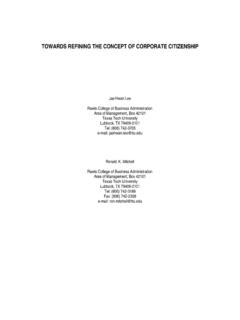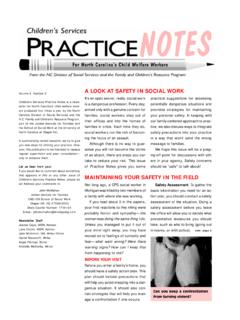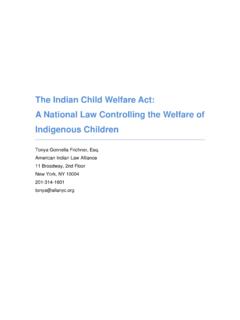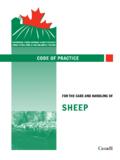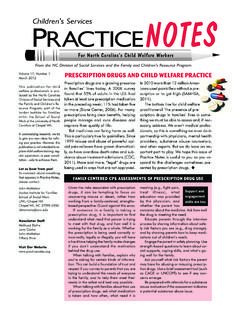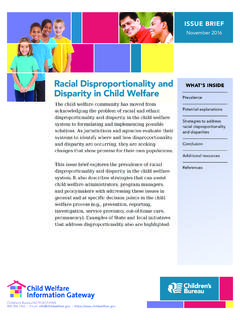Transcription of Stakeholder Agency and Social Welfare: Pluralism …
1 Stakeholder Agency and Social welfare : Pluralism and Decision Making in the Multi-Objective Corporation Journal: Academy of Management Review Manuscript ID: Manuscript Type: Special Research Forum Management Theory & Social welfare Keywords: Social welfare , Stakeholder Theory, Business Ethics, Corporate Governance, Strategic Mission/Vision/Goals, Corporate Social Responsibility Academy of Management ReviewSTAKEHOLDER Agency AND Social welfare : Pluralism AND DECISION MAKING IN THE MULTI-OBJECTIVE CORPORATION Ronald K. Mitchell Texas Tech University, Gary R. Weaver University of Delaware, Bradley R. Agle Brigham Young University, Adam D. Bailey Black Hills State University, James Carlson Texas Tech University Health Science Center, Acknowledgement: We express appreciation for institutional support from the Wheatley Institution and the Bagley Foundation, for research assistance from Camden Robinson, Ben King, and Hilary Hendricks, for our reviewers, and for our incredibly insightful and helpful action and special issue editors Tom Donaldson and Tom Jones.
2 Page 1 of 63 Academy of Management Review1234567891011121314151617181920212 2232425262728293031323334353637383940414 24344454647484950515253545556575859602 ABSTRACT Social welfare , or the good society, is of central concern to the Academy of Management. We begin by observing that, in theory and practice, Social welfare appears to be a multifarious, multi-dimensional, pluralistic concept. In light of this, we develop an account of a multi-objective corporation as a means for enabling a greater range of management decisions, so as to permit more direct corporate engagement in the diverse goals of various stakeholders. In the course of doing this, we critique aspects of single objective theories of corporate function and argue that a key objection to multi-objective views can be avoided. Our analysis is built on a Stakeholder Agency framework wherein corporate actions reflect the outcome of an intra-corporate marketplace.
3 We suggest that improvements in Social welfare are more likely when intra-corporate markets among stakeholders can operate unconstrained by some single-valued objective. Keywords: Stakeholder Social welfare Pluralism Multi-objective Corporation Stakeholder Agency Shareholder Wealth Maximization Corporate Social Responsibility Page 2 of 63 Academy of Management Review1234567891011121314151617181920212 2232425262728293031323334353637383940414 24344454647484950515253545556575859603 It is in the nature of most [persons] to be guided by many stars rather than just one. Davis (1973: 315) Social welfare and the objectives of the modern corporation are inexorably linked ( , Bowen, 1953). Social welfare has been discussed in a variety of disciplines, recently including management ( , Jones & Felps, 2013a, b; Porter & Kramer, 2006). The diversity of perspectives on Social welfare suggests that the concept is pluralistic or multi-dimensional, while much conventional wisdom in business assumes or argues that corporations should have a singular focus on shareholder wealth maximization (SWM) ( , Jensen, 2001, 2002).
4 Such assumptions and arguments arise in part because SWM is asserted to yield Social welfare improvements as Social actors pursue their various interests via profit-generating market transactions ( , Friedman, 1962, 1970; Jensen, 2001, 2002), and in part because of alleged difficulties of multi-objective organizational decision making (Jensen, 2001, 2002). In this article we assume a Stakeholder -agentic perspective on organizations (Hill & Jones, 1992) and, in that context, assert the viability of multi-objective decision making, arguing that such viability opens the door to seeing how corporations can better embody the diverse interests of multiple stakeholders as those stakeholders interact in market-like fashion. We also assume the context and boundary conditions of a market economy. The core mechanism underlying market-economy processes explaining why Social actors will behave in certain ways and achieve particular outcomes is that multiple actors, all seeking their own ends, will respond to the (price) signals and incentives provided by others, and do so without overarching, centralized direction ( , Smith s invisible hand process ([1776] 2003)).
5 In particular, the invisible hand is expected to mobilize resources toward their most desired use Page 3 of 63 Academy of Management Review1234567891011121314151617181920212 2232425262728293031323334353637383940414 24344454647484950515253545556575859604 according to the neoclassical economic notion of Pareto optimality, where no alternative allocation of resources could make one market participant better off without making any other market participant worse off (Arrow, 1974; Jensen, 2001; Stiglitz, 1991). Insofar as the mechanisms of the invisible hand work well ( , reasonably and realistically approximate pre-conditions of perfect markets), Social welfare is expected to be maximized because socioeconomic actors will employ their resources ( , financial, human, etc.) in ways that best satisfy their preferences relative to the incentives and signals provided by others. In this framework, if Social welfare is understood pluralistically, and expressed via the invisible hand choices and actions of multiple Social actors, the receptiveness of the corporate objective to multiple ends may be critical to Social welfare .
6 We began with Davis observation that humanity is guided by many stars. In this article we argue that a credible basis for Social welfare -enhancing decision making by corporate managers will require that theory move away from the possibly convenient but ultimately constraining assertion that coherent corporate decision making requires dependence on single-valued objective approaches (such as SWM, Stakeholder happiness enhancement (SHE) (Jones & Felps, 2013b), customer value creation (Slater, 1997), and other potential candidates). We argue instead that through adoption of a multi-objective approach to managerial decision making, a broader array of invisible hand preferences and market signals can be engaged, opening the door to a more inclusive, less constraining process of corporate contributions to multi-dimensional, pluralistic Social welfare . In what follows, we first visit the literature on Social welfare for the limited purpose of noting the multifarious nature of the concept.
7 We then discuss the general problems affecting efforts to understand the goal and function of corporations in terms of a single objective (whether Page 4 of 63 Academy of Management Review1234567891011121314151617181920212 2232425262728293031323334353637383940414 24344454647484950515253545556575859605 shareholder wealth or some other unitary goal), situating this issue in a long-running debate about value monism and value Pluralism , and noting the reality and viability of multi-objective decision making. Next we consider the prospects for a more encompassing but still single-objective account of the role of corporations vis- -vis Social welfare (using Jones and Felps recent Stakeholder happiness enhancement framework (2013b) as a representative, prima facie viable point of departure, as it is possibly the most encompassing and therefore Social welfare -friendly extension of the single objective function position).
8 Following this, we argue that a single-objective corporation constrains the intra-corporate marketplace that characterizes a Stakeholder -agentic corporation, robbing it of potential combinations of multiple objectives that would be chosen (a) by stakeholders if their various bundles of individual or collective preferences were addressed in distinct, separate markets for their various preferences, and (b) by managers if their invisible hand intra-corporate market interactions with stakeholders were conducted in distinct, Stakeholder preference-specific markets. In sum, we propose that corporations can constitute venues for achieving more for Social welfare than do conventional single-objective firms, by explaining how a Stakeholder agentic corporation can accommodate a Pluralism of objectives and thus avoid some of the Social welfare sacrifices associated with single objective firms. Social welfare Concern for the welfare of society has been fundamental to civilization; and it has been argued that increasing human well-being is one of the motives for organizing society (Durant, 1935).
9 Here we briefly note the breadth of conceptualizations of Social welfare , with the aim of highlighting its overall multifarious, multidimensional nature. Page 5 of 63 Academy of Management Review1234567891011121314151617181920212 2232425262728293031323334353637383940414 24344454647484950515253545556575859606 Discussions of Social welfare , the good life, or good society, are ancient. For example, Aristotle recognized that individual acquisition of the good was laudable, but that it is nobler and more divine to do so for a nation and city (Aristotle, [1999]: 1095). Contemporary (and earlier) philosophy has continued the discussion, arguing for one or another conceptualization of Social welfare , , that it consists of an authentic happiness (Sumner, 1996) involving a set of standard human goods. Meanwhile, other fields add their own conceptualizations to the mix. Table 1 provides a small but illustratively diverse sampling of the range of concepts invoked in articulating Social welfare .
10 Theoretical development and/or empirical examination have been performed in disciplines including philosophy, economics, psychology, sociology, and Social work. Collectively, this research suggests that the meaning of Social welfare has not yet received a strong, cross-disciplinary, unitary consensus among theorists. {Insert Table 1 about here} Economists variously have addressed Social welfare in terms such as the ethical value or the goodness of the state of affairs of the society (Sen, 1991:15), the unweighted summation of individual utilities (Ng, 1975: 546), or a Social maximum derived from individual desires (Arrow, 1950: 329). Although such definitions often treat Social welfare as an aggregation across individuals, economists also have noted questions of interpersonal comparisons (Arrow, 1950: 329), of the role of freedoms and liberties and related challenges to the idea of Social welfare rooted solely in individual welfare (Sen, 1991: 18), and of trade-offs between welfare and justice (Arrow, 1970: 25) (with sociologists Daly and Lewis (2000) complicating such utilitarian/deontological trade-offs by adding in the feminist notion of care ).

